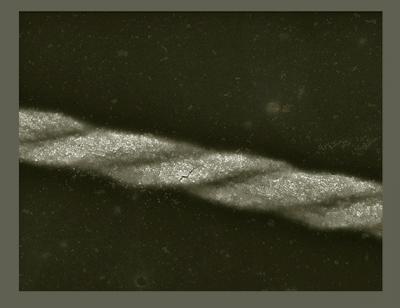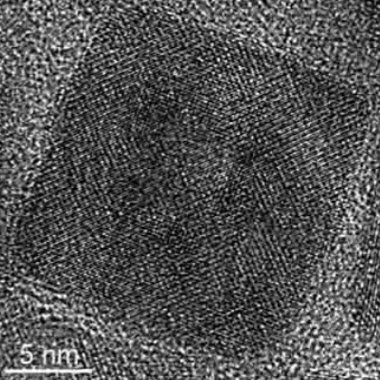Nanocubes of magnetic material align into DNA-like helical structures
August 12, 2014

Scanning electron microscope image of a well-defined double helix (credit: Weizmann Institute of Science)
Weizmann Institute scientists have found that given the right conditions, cube-shaped nanoparticles self-assemble into unexpectedly beautiful and complex helical structures.
The scientists describe their research in the journal Science.
Rafal Klajn, PhD, and postdoctoral fellow Gurvinder Singh, PhD, of the Institute’s Organic Chemistry Department used nanocubes of an iron oxide material called magnetite, which has magnetic properties.
Together with the research group of Prof. Petr Král of the University of Illinois, Chicago, Klajn and Singh developed theoretical models to understand how magnetic and van der Waals molecular force primarily, in addition to Zeeman coupling and entropic forces, could push and pull the tiny bits of magnetite into different formations.

High-resolution transmission electron microscope image of iron-oxide nanocube (credit: Gurvinder Singh et al./Science)
“Different types of forces compel the nanoparticles to align in different ways,” says Klajn.
“These can compete with one another; so the idea is to find the balance of competing forces that can induce the self-assembly of the particles into novel materials.”
Only works with cubes
The models suggested that the shape of the nanoparticles is important — only cubes would provide a proper balance of forces required for pulling together into helical formations.
The researchers found that magnetism causes the magnetic particles to both attract and repel one another, prompting the cubic particles to align at their corners.
Van der Waals forces, on the other hand, pull the sides of the cubes closer together, coaxing them to line up in a row. When these forces act together on the tiny cubes, the result is the step-like alignment that produces helical structures.
In their experiments, the scientists exposed relatively high concentrations of magnetite nanocubes placed in a solution to a magnetic field. The long, rope-like helical chains they obtained after the solution was evaporated were surprisingly uniform.
Future insights into unknown self-assembled materials
Klajn and Singh also found that they could get chiral strands — all wound in the same direction — with very high particle concentrations, in which a number of strands assembled closely together. Apparently the competing forces are affected by the most efficient way to pack the strands into the space, or “maximum packing density.”
“Only once we understand how the various physical forces act on nanoparticles can we begin to apply the insights to such goals as the fabrication of previously unknown, self-assembled materials,”says Klajn.
Curiously, the double-helix form is created without a pre-existing template, as with DNA, the authors note.
Klajn’s research is supported by the Abramson Family Center for Young Scientists, the estate of Olga Klein Astrachan, and the European Research Council.
Abstract of Science paper
Organizing inorganic nanocrystals into complex architectures is challenging and typically relies on pre-existing templates, such as properly folded DNA or polypeptide chains. We report that under carefully controlled conditions, cubic nanocrystals of magnetite self-assemble into arrays of helical superstructures in a template-free manner and a >99% yield. Computer simulations revealed that the formation of helices is determined by the interplay of van der Waals and magnetic dipole-dipole interactions, Zeeman coupling, as well as entropic forces, and is possible due to spontaneous formation of chiral nanocube clusters. We found that neighboring helices within their densely packed ensembles tend to adopt the same handedness in order to maximize packing, thus revealing a novel mechanism of symmetry breaking/chirality amplification.